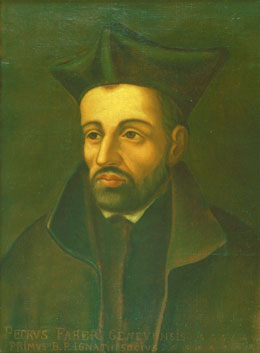Activities for Celebrating Peter Faber
Saint Peter Faber was one of the first Jesuits, a college roommate of St. Ignatius of Loyola. Faber (sometimes referred to as Pierre Favre) was canonized December 17, 2013. Help children learn about Faber with these activities.

10 Quiet Minutes (ages 5–8)
Tell children that Peter Faber was known as “the quiet one” because he liked to take time to think deeply about subjects. Say: This is called meditation. Just as it is important to exercise our bodies and our brains, it is important to let ourselves rest as well. Let’s practice meditation. Invite children to find a comfortable place in the room where they won’t be distracted. Once settled, have children close their eyes and think of a peaceful place, such as their bedroom or a park. Encourage children to invite Jesus to join them in this place and to talk about whatever is on their mind with Jesus. Tell children that this is a time to let their minds wander and think whatever they would like. After ten minutes of quiet meditation, gently call children back to their seats. Invite volunteers to share their thoughts on mediation. Encourage children to practice 10 quiet minutes a day.
Call to Action (Ages 9–12)
St. Ignatius of Loyola and his “friends in the Lord” dreamt of serving God together and founded what became the Society of Jesus. Have children think of an organization they and their friends could found, based on what they value and care about. For example, if the children care about animals, they can brainstorm ways to help animal shelters. Have children write down the motto of the organization, what members believe, and what actions this organization will do to spread the message. If time allows, have children design a logo for their organization. Invite children to share their ideas and display the logos around the room.
Part of the Whole (Ages 13–16)
Peter Faber was considered “the quiet one,” and is not as well known as Ignatius or their other friend, St. Francis Xavier. But his deep contemplation helped him be a good listener and confidante to Ignatius and others. Have young people think about what they are hard on themselves for, such as not doing well on a test or being unkind to a person. Remind young people that this list is private and they do not have to share. Then have young people write ways in which this negative trait or event can be viewed through a positive lens, and how they can adjust to make it better the next time. Say: For example, I think I am too shy in large groups. Instead of dwelling on this, I will ease into groups by seeking out a friendly person who is also on the fringes and get to know that person, one on one. I won’t be hard on myself about this trait any longer. When young people have finished writing their attributes and the positive ways these traits help others, invite them to keep the list in a safe place as a reminder to be like Peter Faber.

